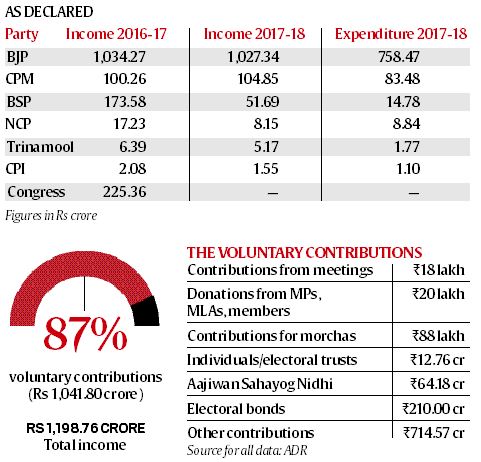The income declared by the six parties that submitted details adds up to Rs 1,198.76 crore. Out of this, the BJP’s Rs 1,034.27 represents 86 per cent.
Five of seven national political parties have declared lower incomes in 2017-18 than in the previous financial year, according to an analysis of their IT returns by the Association for Democratic Reforms. Only the CPM declared an increased income while the Congress was yet to file its IT returns until December 17, ADR said in a statement. The due date was October 30.
The BSP’s declared income showed the sharpest drop, by two-thirds from Rs 173.58 crore to Rs 51.69 crore, while the NCP income dropped by over half from Rs 17.23 crore to Rs 8.15 crore. The BJP’s income decreased less sharply, from Rs 1,034.27 crore to Rs 1,027.34 crore, the analysis found.
The income declared by the six parties that submitted details adds up to Rs 1,198.76 crore. Out of this, the BJP’s Rs 1,034.27 represents 86%. The BJP declared having spent 74% (Rs 758.47 crore) of its income while the BSP spent 29% (Rs 14.78 crore of Rs 51.69 crore). The NCP declared that it spent Rs 8.84 crore, which was more than its income of Rs 8.15 crore.

Out of the Rs 1,198.76 crore, Rs 1,041.80 crore (86%) came from voluntary contributions. The heads under which contributions were declared were electoral bonds, individual donors/electoral trusts, other contributions, Aajiwan Sahayog Nidhi, donations from members, contributions for morchas, contributions from meeting, and other contributions. The highest income – Rs 714.57 crore – was declared under “other contribution”, the ADR analysis shows. Only the BJP declared having received Rs 210 crore from contributions through electoral bonds, the ADR statement said.
In their search for alien life, researchers have often accepted the presence of oxygen in a planet’s atmosphere as the surest sign. A new Johns Hopkins University study, however, recommends a reconsideration of that rule of thumb. Simulating the atmospheres of planets beyond the solar system, researchers successfully created both organic compounds and oxygen, absent of life, the university said in a statement. They published their findings in ACS Earth and Space Chemistry. These serve as a cautionary tale for researchers who suggest the presence of oxygen and organics on distant worlds is evidence of life there, the university said.
Oxygen makes up 20% of Earth’s atmosphere and is considered one of the most robust biosignature gases in Earth’s atmosphere. Beyond the Solar System, little is known about how different energy sources initiate chemical reactions and how those reactions can create biosignatures like oxygen. In a specially designed chamber, researchers tested nine different gas mixtures, consistent with predictions for super-Earth and mini-Neptune type exoplanet atmospheres. Researchers exposed the mixture to one of two types of energy, meant to mimic energy that triggers chemical reactions in planetary atmospheres: plasma from an alternating current glow discharge, or light from an ultraviolet lamp. After running the experiments continuously for three days, the research team found multiple scenarios that produced both oxygen and organic molecules that could build sugars and amino acids -raw materials for which life could begin. This, they said, suggests that even the co-presence of commonly accepted biosignatures could be a false positive for life.

